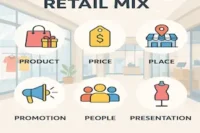From Shelves to Billing: How Organized Retailing Works
Published: 06 Jul 2025
Shopping has become more organized than ever before. When you walk into a big store, everything feels in order. Products are placed neatly, prices are clearly shown, and you get a printed bill after payment. This smooth experience is called organized retailing.
Organized retailing means shopping through a system. These stores follow rules, use modern tools like barcode scanners, and focus on customer service. Everything is planned—from product display to billing.
It’s very different from small street shops where things may be less formal. Organized stores give a better and more trusted shopping experience.
In this blog, you’ll learn what organized retailing means, how it works, and why it matters today. Let’s dive in and make it simple.
What is Organized Retailing?
Organized retailing refers to shopping through stores or businesses that follow a proper system. These stores are registered, use modern technology like billing machines and barcodes, and offer a clean, well-managed shopping experience.
- Stores that follow a proper business system
- Legal registration and tax compliance
- Use of modern tools like POS machines and barcodes
- Clean store layout and clear product displays
- Trained staff and customer service
Example:
Imagine you walk into a supermarket like Imtiaz, Carrefour, or Metro. The store is clean, products are arranged on shelves, prices are displayed, and you get a printed bill at checkout. The staff is trained and helpful. You can even pay using your card or mobile app.
This is a real-life example of organized retailing—a system where everything is planned and managed to give customers a smooth shopping experience.
Importance of Organized Retailing
Organized retailing is important because it makes shopping easy, safe, and reliable. Customers get clear prices, proper bills, and good service. For businesses, it helps manage stock, track sales, and build trust. It also creates jobs and supports the economy by promoting fair trade and brand growth.
- Clear prices and proper billing
- Better customer service
- Trusted shopping experience
- Smooth business operations
- More job opportunities
- Support for brands and the economy
How Organized Retailing Works?
Organized retailing works through a proper system where everything is planned and managed step by step. Products are selected from suppliers, stocked neatly on shelves, and displayed with clear price tags. Customers pick what they need, take it to the billing counter, and the items are scanned using a POS machine.
A printed bill is given, and payment is made through cash, card, or a mobile app. After each sale, the system updates the inventory, keeping everything for the next customer.
- Products are sourced from trusted suppliers.
- Items are neatly arranged with clear price tags.
- Customers browse and pick what they need.
- At checkout, items are scanned using POS machines.
- A printed bill is generated for the customer.
- Payment is made through cash, card, or a mobile app.
- Inventory is updated automatically after the sale.
Types of Organized Retailing
Organized retailing comes in many forms, each designed to meet different shopping needs. Here are the most common types with quick explanations:
Department Stores – Large stores that sell many types of products under one roof.
Supermarkets – Sell groceries and daily-use items in a self-service setup.
Hypermarkets – Bigger than supermarkets, offering both food and non-food items.
Specialty Stores – Focus on one product category like shoes, clothes, or electronics.
Convenience Stores – Small stores located near homes for quick, everyday purchases.
Shopping Malls – A Group of organized retail stores in one large space.
Online Retailing – Websites or apps that let you shop from home.
Franchise Stores – Chain stores run under a common brand and business model.
Benefits of Organized Retailing
There are many benefits of organized retailing listed below:
- Clean and well-managed shopping spaces
- Clear pricing with no bargaining
- Professional customer service
- Easy return and exchange policies
- More payment options (cash, card, mobile apps)
- Better stock and sales tracking for businesses
- Stronger customer trust and loyalty
- Creates jobs and supports the economy
Organized vs Unorganized Retailing
Retailing in today’s world falls into two main types: organized and unorganized. Both serve customers, but they work very differently. Let’s look at how they compare in simple terms.
Organized
- Legally registered businesses
- Uses modern tools like POS and barcodes
- Fixed prices with proper bills
- Clean, well-arranged stores
- Trained staff and good customer service
- Offers return and exchange options
- Follows business rules and tax laws
Unorganized
- Not formally registered or licensed
- Manual billing or no billing at all
- Prices may vary or involve bargaining
- Small or roadside shops with basic setup
- Limited or no customer service
- No clear return or refund policies
- Often outside formal tax systems
Conclusion
So, guys, in this article, we have learned what organized retailing means and how it works. It gives customers a better shopping experience with clean stores, fixed prices, and proper bills. It also helps businesses grow and work better. Organized retailing is growing fast and making shopping easier for everyone.

- Be Respectful
- Stay Relevant
- Stay Positive
- True Feedback
- Encourage Discussion
- Avoid Spamming
- No Fake News
- Don't Copy-Paste
- No Personal Attacks



- Be Respectful
- Stay Relevant
- Stay Positive
- True Feedback
- Encourage Discussion
- Avoid Spamming
- No Fake News
- Don't Copy-Paste
- No Personal Attacks


